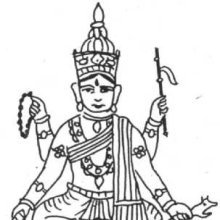Duritari, Duritāri, Duritārī: 6 definitions
Introduction:
Duritari means something in Jainism, Prakrit, Hinduism, Sanskrit. If you want to know the exact meaning, history, etymology or English translation of this term then check out the descriptions on this page. Add your comment or reference to a book if you want to contribute to this summary article.
Images (photo gallery)
In Jainism
General definition (in Jainism)
Source: archive.org: The Jaina IconographyDuritāri (दुरितारि) or Prajñapti is the name of the Yakṣiṇī accompanying Sambhavanātha: the third of twenty-four Tīrthaṃkaras or Jinas, commonly depicted in Jaina iconography.—The Jina’s symbol of horse, which in India is regarded as auspicious originates from the idea of good chance associated with his name. His Yaksa’s emblem of a mongoose Skt. Sarvatobhadra (lucky on all sides), and the Yakṣiṇī’s name as Duritāri, meaning “vanquisher of enemies” and her symbols of Varada-mudrā, fruit and Abhaya all very clearly bespeak the same idea of auspiciousness or “good chance”.
The first name [Duritārī] belongs to the Śvetāmbara representation, the second [Prajñapti] to the Digambara. Duritārī rides a ram and is four-handed. The hands hold Varada, rosary, fiuit and Abhaya. The Digambara Prajñapti places herself upon a bird. She has six hands, which are adorned with an axe, crescent, fruit, sword, (Iḍhi) and Vara-mudrā.
Source: archive.org: TrisastisalakapurusacaritraDuritāri (दुरितारि) is the name of a Yakṣiṇī (i.e., Śāsanadevatā) associated with Sambhava, according to chapter 3.1 [sambhava-jina-caritra] of Hemacandra’s 11th century Triṣaṣṭiśalākāpuruṣacaritra: an ancient Sanskrit epic poem narrating the history and legends of sixty-three illustrious persons in Jainism.
Accordingly: “There appeared in that congregation a Yakṣa-chief, named Trimukha, three-eyed, three-faced, dark, six-armed, with a peacock for a vehicle, carrying an ichneumon and a club in two right hands and bestowing fearlessness with a third, carrying a citron, wreath, and rosary in his left hands. In the same congregation there arose Duritāri, four-armed, fair, with a ram for a vehicle, adorned with right arms holding a rosary and granting a boon, and with left arms holding a serpent and bestowing fearlessness. Then the messenger-deities, Trimukha and Duritāri, were always near the Lord, like a body-guard”.

Jainism is an Indian religion of Dharma whose doctrine revolves around harmlessness (ahimsa) towards every living being. The two major branches (Digambara and Svetambara) of Jainism stimulate self-control (or, shramana, ‘self-reliance’) and spiritual development through a path of peace for the soul to progess to the ultimate goal.
Languages of India and abroad
Sanskrit dictionary
Source: Cologne Digital Sanskrit Dictionaries: Monier-Williams Sanskrit-English DictionaryDuritāri (दुरितारि):—[=dur-itāri] [from dur-ita > dur] f. ‘enemy of sin’, Name of a Jaina goddess
Source: DDSA: Paia-sadda-mahannavo; a comprehensive Prakrit Hindi dictionary (S)Duritāri (दुरितारि) in the Sanskrit language is related to the Prakrit word: Duriāri.
[Sanskrit to German]
Sanskrit, also spelled संस्कृतम् (saṃskṛtam), is an ancient language of India commonly seen as the grandmother of the Indo-European language family (even English!). Closely allied with Prakrit and Pali, Sanskrit is more exhaustive in both grammar and terms and has the most extensive collection of literature in the world, greatly surpassing its sister-languages Greek and Latin.
See also (Relevant definitions)
Full-text: Duriari, Trimukha, Prajnapti, Sambhavanatha, Sarvatobhadra.
Relevant text
Search found 5 books and stories containing Duritari, Duritāri, Duritārī, Dur-itari, Dur-itāri; (plurals include: Duritaris, Duritāris, Duritārīs, itaris, itāris). You can also click to the full overview containing English textual excerpts. Below are direct links for the most relevant articles:
Trishashti Shalaka Purusha Caritra (by Helen M. Johnson)
Part 15: Sambhava’s messenger-deities (śāsanadevatās) < [Chapter I - Sambhavajinacaritra]
Jain Remains of Ancient Bengal (by Shubha Majumder)
Images of Tīrthaṅkara Saṃbhavanātha < [Chapter 6 - Iconographic Study of Jaina Sculptural Remains]
The twenty-four Tīrthaṅkaras and their Yakṣas and Yakṣiṇīs < [Chapter 6 - Iconographic Study of Jaina Sculptural Remains]
Jainism in Odisha (Orissa) (by Ashis Ranjan Sahoo)
Iconography of Jain Gods and Goddess < [Chapter 6]
Chaitanya Bhagavata (by Bhumipati Dāsa)
Verse 3.1.121 < [Chapter 1 - Meeting Again at the House of Śrī Advaita Ācārya]
A study of the philosophy of Jainism (by Deepa Baruah)
Chapter I.c - The lives of the Tīrthaṅkaras < [Chapter I - Introduction]
